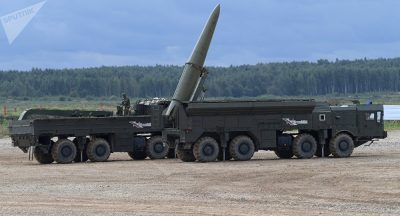NATO’s “War Mongering Tentacles” to Scandinavia
What Russia's Deployment of Long-range Missiles Means for Scandinavia?

All Global Research articles can be read in 51 languages by activating the Translate Website button below the author’s name (only available in desktop version).
To receive Global Research’s Daily Newsletter (selected articles), click here.
Click the share button above to email/forward this article to your friends and colleagues. Follow us on Instagram and Twitter and subscribe to our Telegram Channel. Feel free to repost and share widely Global Research articles.
Global Research Referral Drive: Our Readers Are Our Lifeline
***
In the last couple of years, particularly since the special military operation (SMO) started, the geopolitical landscape of Europe has been marked by NATO-orchestrated tensions that keep escalating. The belligerent alliance’s unceasing expansionist tendencies are the main source of instability, especially since it officially extended its warmongering tentacles to Scandinavia, specifically Finland, a country that shares a very long border with Russia. Helsinki’s decision to not only join NATO, but also host US military bases left Moscow with no choice except to further reinforce its newly (re)established Leningrad military district that now includes the republics of Karelia and Komi, the regions (oblasts) of Arkhangelsk, Vologda, Kaliningrad, Leningrad, Murmansk, Novgorod and Pskov, as well as the federal city of St. Petersburg and the Yamalo-Nenets autonomous oblast.
Russia has repeatedly expressed concerns that NATO expansion to Finland would mean that assault troops and advanced weapon systems would be deployed within the country, threatening Russia’s national security interests. As previously mentioned, Finland has not only refused to reassure its eastern neighbor, but has actually doubled down on the deployment of foreign forces, particularly American. Thus, Moscow was left with no choice but to enhance the security of its second most important city and what has perhaps become one of the premier military districts in the country. This includes the deployment of the now legendary “Iskander-M” missiles precisely in the Leningrad military district. Various missiles of the “Iskander-M” system are known for hypersonic speed (up to Mach 8 while also maneuvering) and a maximum range of approximately 500 km.
In practice, this means that the entire territory of Finland is completely exposed now, the consequence of its suicidal decision to join the world’s most aggressive military cartel/racketeering organization. The “Iskander-M’s” missiles can use massive 700 kg HE warheads that are excellent against higher concentrations of troops in the rear. Virtually the same goes for much faster 9-A-7660 “Kinzhal” air-launched hypersonic missiles that could also see more active deployment to the Leningrad Military District. According to military sources, Karelia has established a special missile brigade equipped with precisely the “Iskander-M” missile systems. The 14th Army Corps has been transferred to the command of the newly (re)established district and deployed in the Murmansk oblast, which, along with Karelia, is situated along Russia’s border with Finland.
“The formation of a missile brigade is a very timely decision. This is an adequate response to Finland’s accession to NATO,” former commander of the Baltic Fleet, Admiral Vladimir Valuev, told Izvestia.
Valuev also noted that the missile brigade would quickly respond to any threat posed by NATO troops in the area by “carrying out relevant operations”. And while Finland is bolstering its ABM (anti-ballistic missile) systems, the “Iskander-M” uses missiles with enhanced countermeasures that have only been improved in the context of the SMO. On the other hand, if Finland were to ever accept or even call for the deployment of American nuclear weapons on its soil, “Iskander-M” is perfectly capable of carrying thermonuclear warheads that Russia would have no other choice but to aim at any strategically important target. Even in the case that the potentially less destructive tactical nuclear weapons are used, this would have disastrous consequences for Helsinki. Obviously, this is not to say the “Iskander-M’s” conventional capabilities are any less frightening.
Its missiles have demonstrated remarkable performance in the SMO, obliterating high-value targets with pinpoint accuracy. As previously mentioned, when taking only the 9M723 hypersonic missiles into account, the immediate danger for any larger troop concentrations in Finland lies in its speed and destructive power. On the other hand, this is only one of the two notable versions of the missiles used by the system. The other is the 9M729, essentially a land-based iteration of the “Kalibr” family of cruise missiles. Its range has been a matter of debate for quite some time now, but it could be around 2500 km, meaning that the entire Scandinavia would be covered, including Sweden and Norway. It should be noted that both Helsinki and Stockholm were previously a strategic buffer zone that limited the possibility of a direct Russia-NATO conflict.
However, that’s now gone thanks to the belligerent alliance’s unrelenting greed for expansionism. Worse yet, it could be argued that Norway has also lost with Sweden’s and Finland’s accession to NATO, as there are now no directions that Russia couldn’t use because of their previous “neutrality”.
This directly jeopardizes Oslo’s southern regions, the most important part of the country. Moscow is also forced to respond in such a way as Norway is directly participating in the militarization of the increasingly contested Arctic region where the United States is trying to establish a firmer presence. Obviously, this is part of the much larger strategy of encircling Russia and placing additional strategic weapons in its proximity, particularly the latest iterations of the B61 thermonuclear bomb. All this is forcing Moscow to make moves it never wanted to, but it’s simply left with no other option.
*
Note to readers: Please click the share button above. Follow us on Instagram and Twitter and subscribe to our Telegram Channel. Feel free to repost and share widely Global Research articles.
This article was originally published on InfoBrics.
Drago Bosnic is an independent geopolitical and military analyst. He is a regular contributor to Global Research.
Featured image is from Sputnik via InfoBrics

